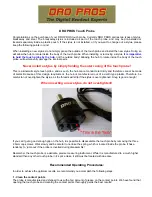
SKU 38413
For technical questions, please call 1-800-444-3353.
Page 3
4.
Make sure your work area is well lighted.
5.
Clean and uncluttered work spaces contribute to safe and productive work conditions.
Before Operating
1.
Check for damaged parts. Before using any tool, any part that appears damaged should
be carefully checked to determine that it will operate properly and perform its intended
function.
2.
Check for alignment and binding of all moving parts, broken parts or mounting fixtures and
any other condition that may affect proper operation. Any part that is damaged should be
properly repaired or replaced by a qualified technician.
Operation
1.
Never force the tool or attachment to do the work of a larger industrial tool. It is designed
to do the job better and more safely at the rate for which it was intended.
2.
Never use the blades if they are dull, worn, or chipped. Blades must be sharpened, re-
paired or replaced before using.
3.
Check to make sure all bolts are secure but not overtightened. Check for blade clearance.
Make sure clearance is suitable for the workpiece.
4.
While being used, the lower blade must be secured with the Clamp. When not being used,
the Clamp (10) can be loosened.
5.
Minor assembly of the Throatless Shear is required. Assemble the Handle (6) over the
exposed shaft of the Geared Handle (4) and tighten Bolt (5).
Using the Throatless Shear
1.
Adjust the clearance between the Upper Blade (14) and Lower Blade (8). To decrease the
clearance, turn the Adjusting Bolts (15) clockwise. To increase clearance, turn the bolts
counterclockwise. The clearance can be adjusted to between 1/4 and 1/10 of the thickness
of the workpiece.
2.
To gain power and control of the workpiece, start all cuts at the heel of the blades. Circu-
lar and irregular cuts are made by turning the workpiece while following through with the
downward stroke of the blade.
3.
When a cut has been finished, push the workpiece forward while raising the handle to lift
the blade above the workpiece. Start the next cut at the heel of the blade.
4.
Always keep the material being cut flat on the bed of the shear.
























